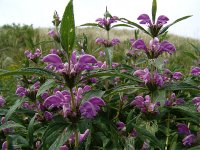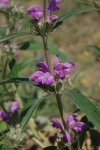Zopnik prickly - phlomis pungens willd.
Family of labial flowers - Lamiaceae (Labiatae)
Botanical characteristics. Perennial herbaceous plant. Roots are thick, sinuous. Stems 30-60 cm tall, strongly branched from the base, greyish-felt from the pubescence. Leaves with flat pubescent petioles, radical with long, and stems with shorter ones. The leaf plates at the base are rounded or broadly wedged, pointed at the apex, solid at the apex, serrate in the middle. Flowers of 3-10 are collected in whorls in the sinuses of the apical leaves. Corollas bilabiate, pink to 10-13 mm. Fruits 4-nutlets, dark-brown, finely dulciform in calyx. Blossoms in June - July, fructifies in July - August.
Spread. It grows in the steppes, on the slopes of gullies and river valleys, in forest glades, among bushes, in groups or small thickets.
Used parts of the plant. Medicinal raw materials are the roots, the aerial part of the plant, collected in the usual way. Dry in dryers at a temperature of 50-60 ° C.
Chemical composition. The plant contains essential oil, iridoids, alkaloids, flavonoids: genkvanin, luteolin, apigenin; Diterpenoids: phytol; Steroids, phenolcarboxylic acids and their derivatives: coffee, ferulic, chlorogenic, quinine; Vitamins: C, B2, E, K, carotene; Microelements.
Application. The above-ground part of the plant is included in the collection according to the inscription of M.N. Zdrenko, used for bladder papillomatosis, anacid gastritis. In folk medicine, decoction, infusion and tincture of zopnik are used for bronchitis, pulmonary tuberculosis, pneumonia, acute respiratory infections, chronic and hypocidal gastritis, stomach ulcer, anemia, hemorrhoids, asthenia, malaria, edema of various etiologies and hypertension; Infusion of flowers and leaves - as a tonic diuretic, increases immunity and accelerates blood clotting; Externally - with purulent wounds; In the form of baths - with rheumatism.
In the experiment the preparations of the aerial part show antibacterial activity; Essential oil shows protistotsidnuyu, seeds - antitrihomonadnuyu activity. Root powder is used as a wound-healing agent. In some countries, roots are used as a food product. Fresh juice of a flowering plant is used as a cosmetic for removing pigment spots and acne; Inside as a general restorative for avitaminosis and diathesis. The decoction of seeds is used to treat trichomonas infection inside and outward.
Preparation
- For broth take 10 grams of seeds, pour 200 ml of boiling water, insist on a boiling water bath for 30 minutes, cool 10 minutes, without removing from the bath, filter. Take 2 tbsp. Spoon 2-3 times daily before meals.
- For infusion of 20 g of the aboveground part of the plant, 200 ml of boiling water is poured, it is insisted on the bath for 15 minutes, it is cooled for 45 minutes, filtered. Take 1/3 cup 2-3 times daily before meals.
- Tincture from the roots is prepared at the rate of 1: 5 on 70% alcohol, insist in a dark place for 10-12 days, filter. Take should be 30-40 drops per reception 3-4 times a day.





Comments
Commenting on, remember that the content and tone of your message can hurt the feelings of real people, show respect and tolerance to your interlocutors even if you do not share their opinion, your behavior in the conditions of freedom of expression and anonymity provided by the Internet, changes Not only virtual, but also the real world. All comments are hidden from the index, spam is controlled.